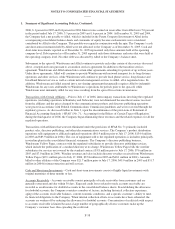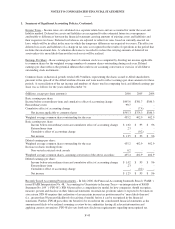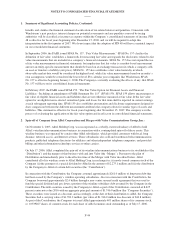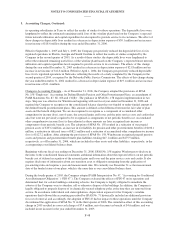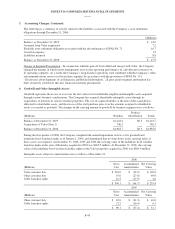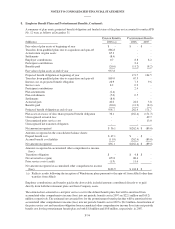Windstream 2006 Annual Report Download - page 149
Download and view the complete annual report
Please find page 149 of the 2006 Windstream annual report below. You can navigate through the pages in the report by either clicking on the pages listed below, or by using the keyword search tool below to find specific information within the annual report.
NOTES TO CONSOLIDATED FINANCIAL STATEMENTS
3. Accounting Changes, Continued:
its operating subsidiaries in Texas to reflect the results of studies for these operations. The depreciable lives were
lengthened to reflect the estimated remaining useful lives of the wireline plant based on the Company’s expected
future network utilization and capital expenditure levels required to provide service to its customers. The effect of
these changes in depreciable lives resulted in a decrease in depreciation expense of $30.1 million and an increase
in net income of $18.6 million during the year ended December 31, 2006.
Effective September 1, 2005 and July 1, 2005, the Company prospectively reduced the depreciable lives for its
regulated operations in Florida, Georgia and South Carolina to reflect the results of studies completed by the
Company in the second quarter of 2005. As a result of these studies, the depreciable lives were lengthened to
reflect the estimated remaining useful lives of the wireline plant based on the Company’s expected future network
utilization and capital expenditure levels required to provide service to its customers. The effects of this change
during the year ended December 31, 2005 resulted in a decrease in depreciation expense of $21.8 million and an
increase in net income of $12.8 million. Effective April 1, 2004, the Company prospectively reduced depreciable
lives for its regulated operations in Nebraska, reflecting the results of a study completed by the Company in the
second quarter of 2004, as required by the Nebraska Public Service Commission. The effects of this change during
the year ended December 31, 2004 resulted in a decrease in depreciation expense of $19.1 million and an increase
in net income of $11.4 million.
Change in Accounting Principle – As of December 31, 2006, the Company adopted the provisions of SFAS
No. 158 “Employers’ Accounting for Defined Benefit Pension and Other Postretirement Plans, an amendment of
FASB Statements No. 87, 88, 106 and 132(R)”. The guidance in SFAS No. 158 requires implementation in two
steps. Step one was effective for Windstream beginning with our fiscal year ended on December 31, 2006 and
required the Company to recognize on the consolidated balance sheet the over-funded or under-funded amount of
the defined benefit postretirement plans. This amount is defined as the difference between the fair value of plan
assets and the benefit obligation. We are also required to recognize as a component of accumulated other
comprehensive income (loss), net of taxes, the actuarial gains and losses and the prior service costs and credits that
arise but were not previously required to be recognized as components of net periodic benefit cost. Accumulated
other comprehensive income (loss) is then adjusted as these amounts are later recognized into income as
components of net periodic benefit cost. The adoption of SFAS No. 158 resulted in a reduction of our prepaid
pension assets of $103.2 million, an increase in our liability for pension and other postretirement benefits of $106.1
million, a reduction in deferred taxes of $82.1 million and a reduction of accumulated other comprehensive income
(loss) of $127.2 million. After adopting the provisions of SFAS No. 158, Windstream recognized prepaid pension
assets and pension and postretirement benefit plan liabilities totaling $47.1 million and $275.5 million,
respectively, as of December 31, 2006, which are included in other assets and other liabilities, respectively, in the
accompanying consolidated balance sheet.
Beginning with our fiscal year ending on December 31, 2008, SFAS No. 158 requires Windstream to disclose in
the notes to the consolidated financial statements additional information about the expected effects on net periodic
benefit cost of delayed recognition of the actuarial gains and losses and the prior service costs and credits. It also
requires disclosure of information about any transition asset or obligation remaining from the application of
pre-existing rules and requires a year-end measurement date. We currently use December 31 as the measurement
date of the funded status of our plans, which is the same date as our consolidated balance sheet.
During the fourth quarter of 2005, the Company adopted FASB Interpretation No. 47, “Accounting for Conditional
Asset Retirement Obligations” (“FIN 47”). The Company evaluated the effects of FIN 47 on its operations and
determined that, for certain buildings containing asbestos, the Company is legally obligated to remediate the
asbestos if the Company were to abandon, sell or otherwise dispose of the buildings. In addition, the Company is
legally obligated to properly dispose of its chemically-treated telephone poles at the time they are removed from
service. In accordance with federal and state regulations, depreciation expense for the Company’s wireline
operations that followed the accounting prescribed by SFAS No. 71 historically included an additional provision
for cost of removal, and accordingly, the adoption of FIN 47 had no impact to these operations until the Company
discontinued the application of SFAS No. 71 in the third quarter of 2006. The cumulative effect of this accounting
change in 2005 resulted in a non-cash charge of $7.4 million, net of income tax benefit of $4.6 million, and was
included in net income for the year ended December 31, 2005.
F-48


